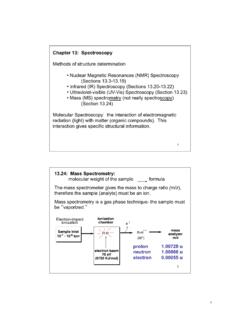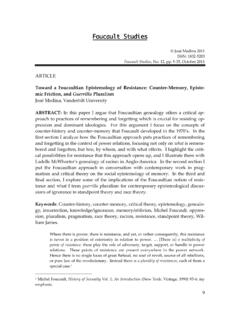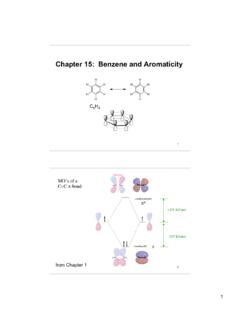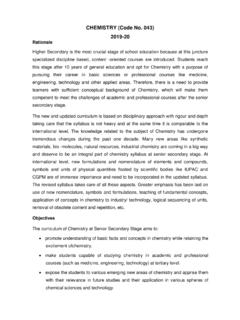Transcription of Chapter 14: Organometallic Compounds - Reagents with ...
1 1302 Chapter 14: Organometallic Compounds - Reagents withcarbon-metal : Organometallic nomenclature (please read)CCHHMgBrHvinylmagnesium bromideH3CH2CH2CH2C-LiButyllithium(H3C)2 Cu- Li+Dimethylcopper : Carbon-Metal Bonds in Organometallic CompoundsMgXC!-!+C_Carbanions: nucleophile react with electrophileXC!+!-Alkyl halides:electrophilesMgXCXC303 Alkyl halides will react with some metals (M0) in ether or THF to form Organometallic Reagents : Preparation of Organolithium CompoundsOrganolithium Organolithium CompoundsCompoundsR-X R-Li + LiX2 Li(0)diethyl etherLiC!-!+C_very strong basesvery strong nucleophilesorganolithium Reagents are most commonly used as very strongbases and in reactions with carbonyl compoundsR-X R-M R-H + M-OH H2OM(0) : Preparation of Organomagnesium Compounds : Grignard ReagentsR-X R-MgX (Grignard reagent)Mg(0)THFR-X can be an alkyl, vinyl, or aryl halide (chloride, bromide, or iodide)Solvent: diethyl ether (Et2O) or tetrahydrofuran (THF)Alcoholic solvents and water are incompatible with Grignard Reagents and organolithium of the alkyl halide: -I > -Br > -Cl >> -F alkyl halides > vinyl or aryl halidesOH3CH2 COCH2CH3diethyl ether (Et2O) tetrahydrofuran (THF)305 BrHOMg0 MgBrHO_HO_BrMgH3O+HOHO ther incompatible groups:-CO2H, -OH, -SH, NH2, CONHR (amides)Reactive functional groups.
2 Aldehydes, ketones, esters, amides, halides, -NO2, -SO2R, nitriles The solvent or alkyl halides can not contain functional groupsthat are electrophilic or acidic. These are incompatible with theformation of the organomagnesium or organolithium Reagents will deprotonate : Organolithium and Organomagnesium Compounds as Br nsted Bases - Grignard Reagents (M = MgX) and organolithium Reagents (M = Li) are very strong + H2O R-H + M-OH pKa pKa(CH3)3C-H71 H2N-H36H3CH2C-H62 26H3C-H60 Water164543 CCHHHHHHHHHHCCHHH ydrocarbons are very weak acids; their conjugate bases are very strong and magnesium acetylidesCCRHH3C-H2C-MgBr+CCRMgBrH3C-H2 C-H+ : Synthesis of Alcohols Using Grignard ReagentsGrignard Reagents react with aldehydes, ketones, and estersto afford alcoholsCO! +! -COR:RCOetherMgXH3O+RCOHMgXCCRHH3C-H2C-H 2C-H2C-Literminalacetylene(pKa ~ 26)+CCRLiH3C-H2C-H2C-H2C-H+THFbutyllithi umlithiumacetylidepKa > 604308 Grignard Reagents react with.
3 Formaldehyde (H2C=O) to give primary alcohols aldehydes to give secondary alcoholsketones to give tertiary alcoholsesters to give tertiary alcoholsBrMg0, etherMgBr1) H2C=O2) H3O+OHBrMgBrMg0, ether1) 2) H3O+HOOHMg0, ether1) 2) H3O+OOHCCHHHBrCCHHHMgBr2 Mg0, ether1) 2) H3O+2 H3C-Br2 : Preparation of Tertiary Alcohols From Esters and Grignard Reagents - mechanism:COCH2CH3O2 H3C-MgBr+1) THF2) then H3O+COHCH3CH3 BrMg(0)etherMgBrOO_H3O+OOHO=C=OReaction of Grignard Reagents with CO2 (Lab, Chapter ) : Synthesis of Acetylenic : Synthesis of Alcohols Using Organolithium ReagentsOrganolithium Reagents react with aldehydes, ketones, and esters in the same way that Grignard Reagents +RCOHR-Li+LiCCRH+ NaNH2 CCR+ NH3Na+pKa~ 36 CCRH+ H3C(H2C)H2C-LiCCR+ H3C(H2C)CH3Li+pKa > 60 CCRH+ H3CH2C-MgBrCCR+ H3 CCH3 MgBr+pKa > 60pKa~ 26311 Recall from Chapter anions react with ketones and aldehydes to form a C-C bond; the product is an acetylenic (propargyl) alcohols R2R3CO+R1CC_MgBr +THFR1 CCCR3 OHR2then H3O+acetylenic alcoholR1CC_Na ++THFR1 CCCH2R2+ NaBrnew C-Cbond formedSN2acetylide anion1 alkyl : Retrosynthetic Analysis - the process of planning a synthesis by reasoning backward from the the target moleculeto a starting compound using known and reliable reactions.
4 It is a problem solving technique for transforming the structure of a synthetic target molecule (TM) to a sequence of progressively simpler structures along the pathway which ultimately leads to simple or commercially available starting materials for a chemical synthesis. The transformation of a molecule to a synthetic precursor is accomplished by:Disconnection: the reverse operation to a synthetic reaction; the hypothetical cleavage of a bond back to precursors of the target Group Interconversion (FGI): the process of converting one functional group into another by substitution, addition, elimination, reduction, or oxidation313 Each precursor is then the target molecule for further retrosynthetic analysis. The process is repeated until suitablestarting materials are (Z)-2-hexene from : Alkane Synthesis Using Organocopper Reagents2 CH3Li + CuIetherCu Li+H3CH3C_+ LiIGilman's reagent (dimethylcuprate, dimethylcopper lithium)R2 CuLi = R- strong nucleophilesNucleophilic substitution reactions with alkyl halides andsulfonates (alkylation)H3C(H2C)8H2C-I + (H3C)2 CuLi H3C(H2C)8H2C-CH3 + CH3Cu + LiISN2 reaction of cuprates is best with primary and secondary alkyl halides; tertiary alkyl halides undergo E2 elimination.
5 Ether315Br4 Li(0), etherLi22 CuLi2 CuIBr24 Li(0), etherLiCuICuLi2 Vinyl and aryl (but not acetylenic) cupratesCuLi2 CuLi2++OTsITHFTHF8316 Reaction of cuprates with aryl and vinyl halidesHHI(H3C)2 CuLiHHCH3double bond geometryis preservedBr(H3CH2CH2C) : Carbenes and : Carbenes and CarbenoidsCarbenoidsCarbene: highly reactive intermediate, 6-electron species. The carbon is sp2 hybridized; it possesses a vacant hybridized p-orbital and an sp2 orbital with a non-bonding pair of electrons317 The cyclopropanation reaction takes place in a single step. There is NO intermediate. As such, the geometry of the alkene is preserved in the product. Groups that are trans on the alkene will end up trans on the cyclopropane product. Groups that are cis on the alkene will end up cis on the cyclopropane and Reaction of Dihalocarbenes:CHCl3 + KOH Cl2C: + H2O + KCldichlorocarbeneHHRRcis-alkeneHHRRcis- cyclopropaneHRRH trans-alkeneHRRH trans-cyclopropaneBrBrClClCHCl3, KOHCHBr3, KOHC arbenes react with alkenes to give cyclopropanes.
6 9318 HHRRcis-alkeneCH2I2, Zn(Cu)etherHHRRcis-cyclopropaneHRRH trans-alkeneCH2I2, Zn(Cu) : An Organozinc Reagent for : An Organozinc Reagent for Cyclopropane Cyclopropane SynthesisSynthesisSimmons-Smith ReactionCH2I2 + Zn(Cu)etherI-CH2-Zn-I = H2C:carbeneCH2I2, Zn(Cu)HHetherThe geometry of the alkene is preserved in the cyclopropanation : Transition-Metal Organometallic Compounds (please read) : Homogeneous Catalytic Hydrogenation (please read)H2, Pd/C - The catalyst is insoluble in the reaction media:heterogeneous catalysis, interfacial reaction H2, (Ph3P)3 RhCl - The catalyst is soluble in the reaction media:homogeneous : Olefin Metathesis (please read) : Ziegler-Natta Catalysis of Alkene Polymerization (please read)













